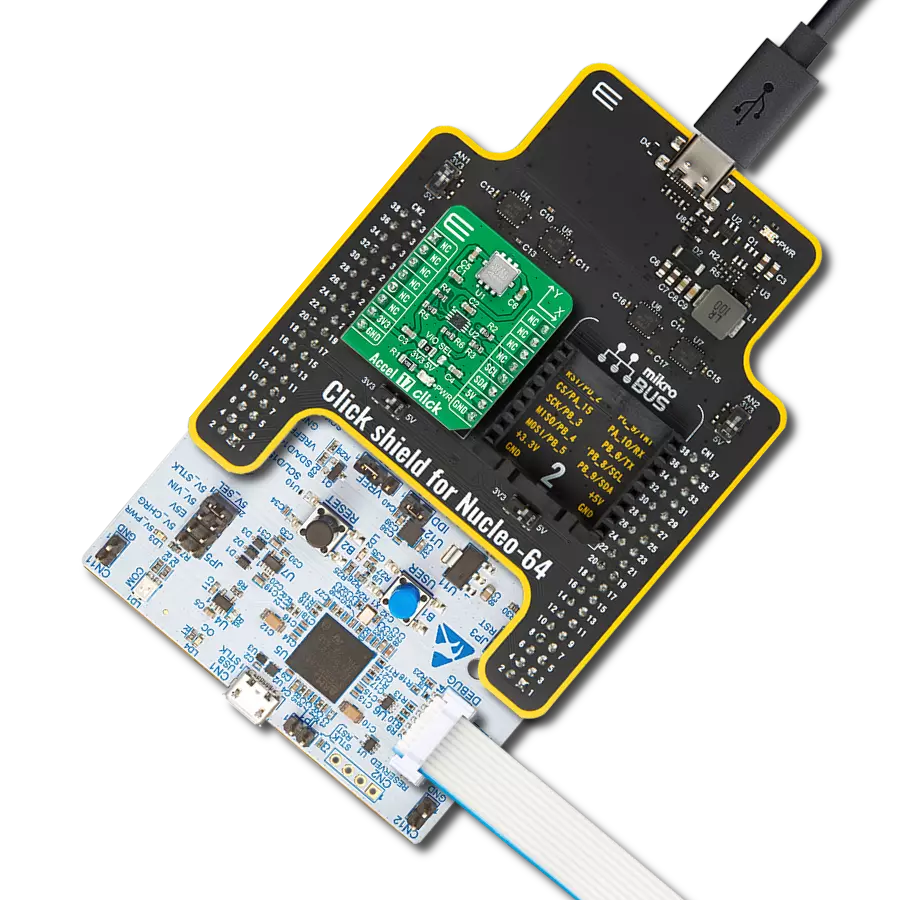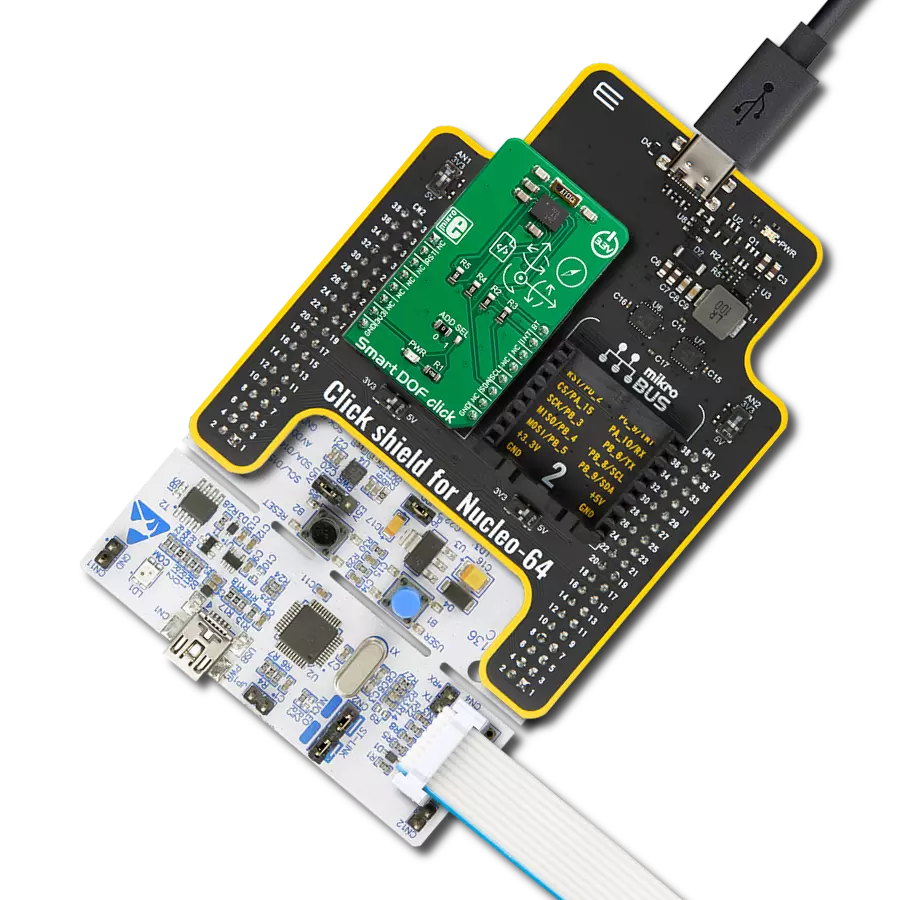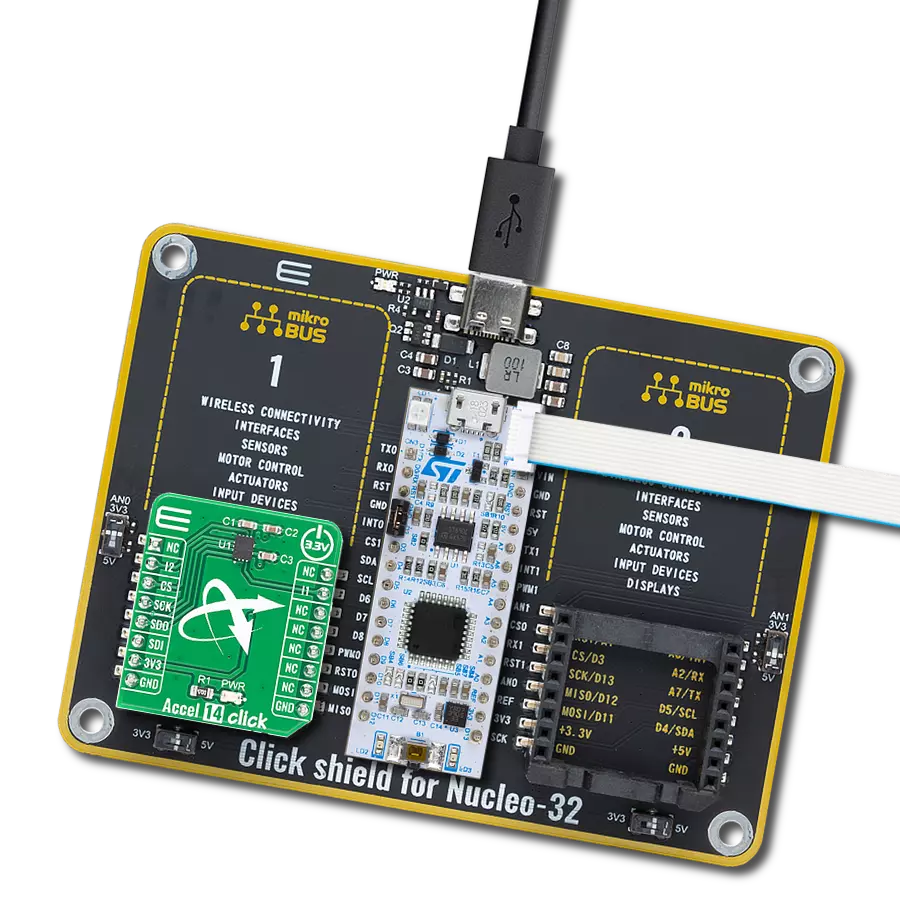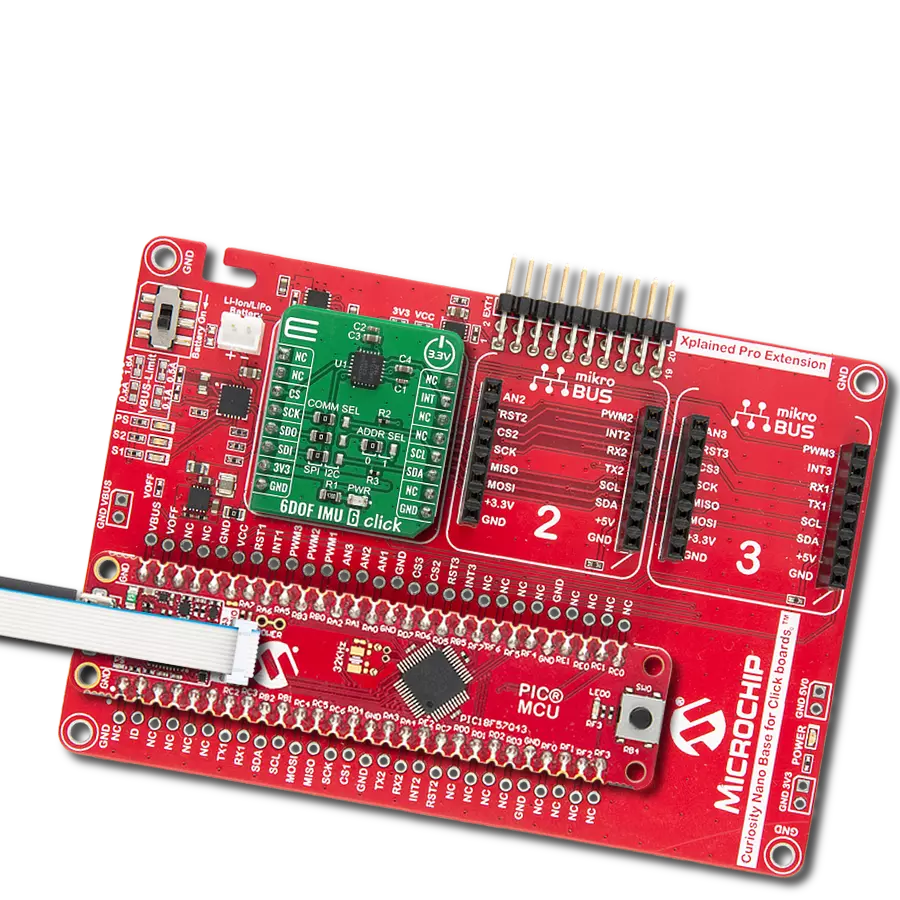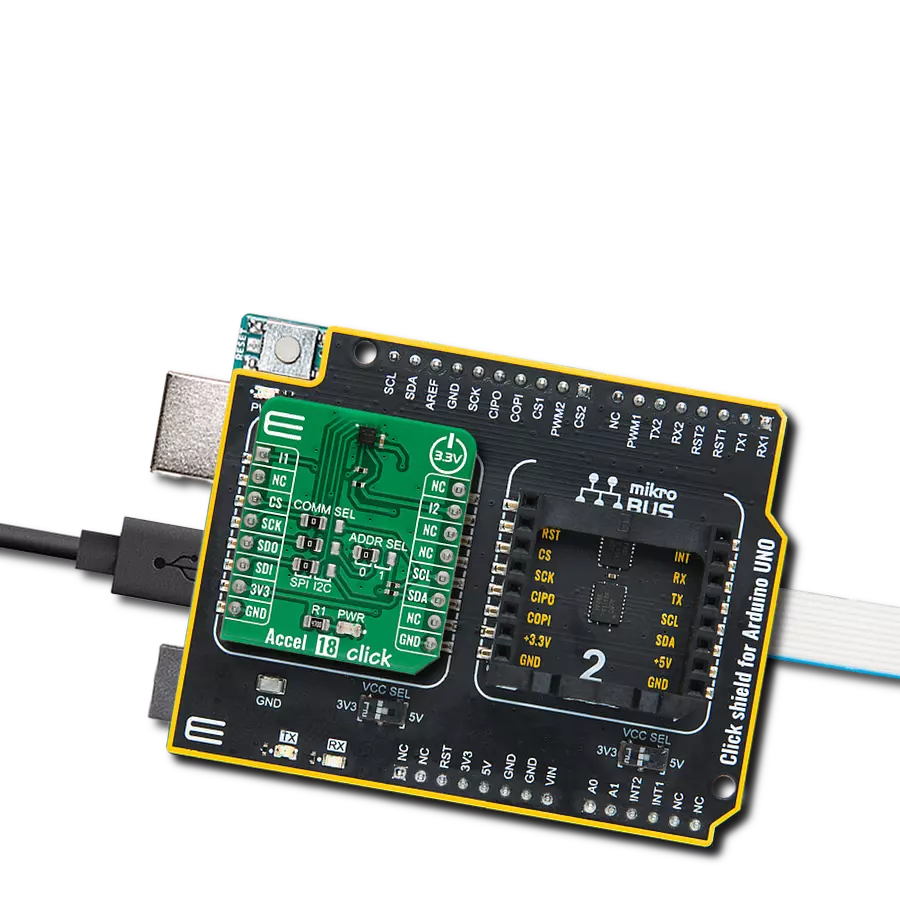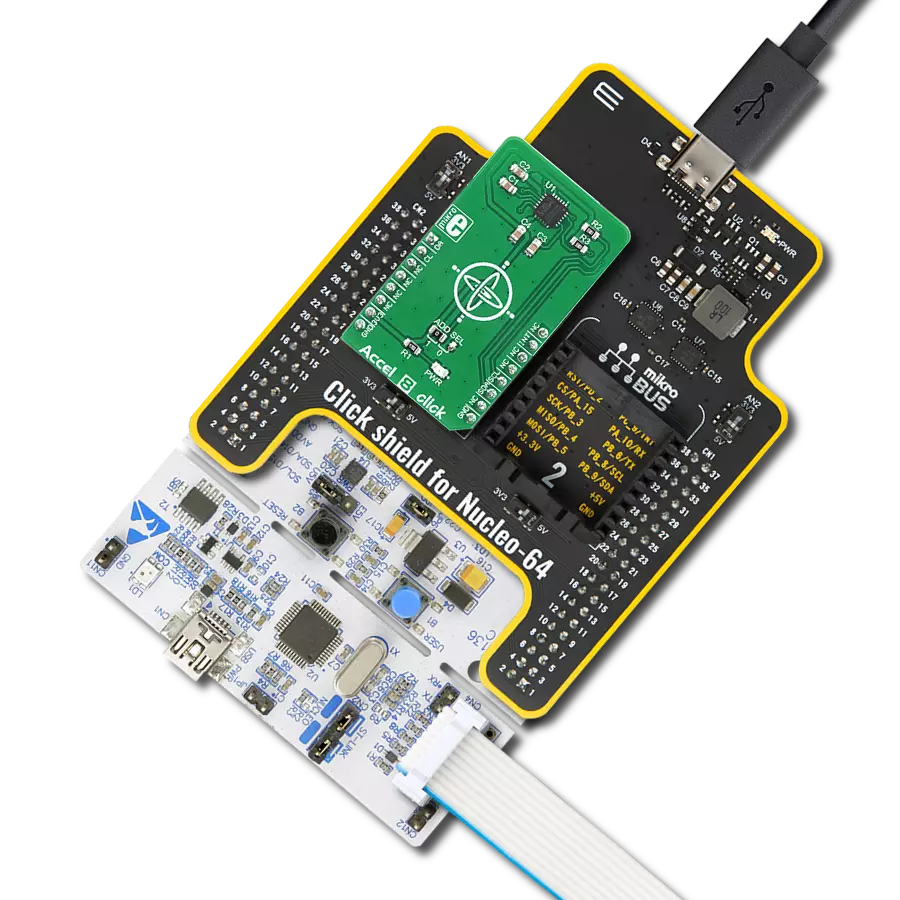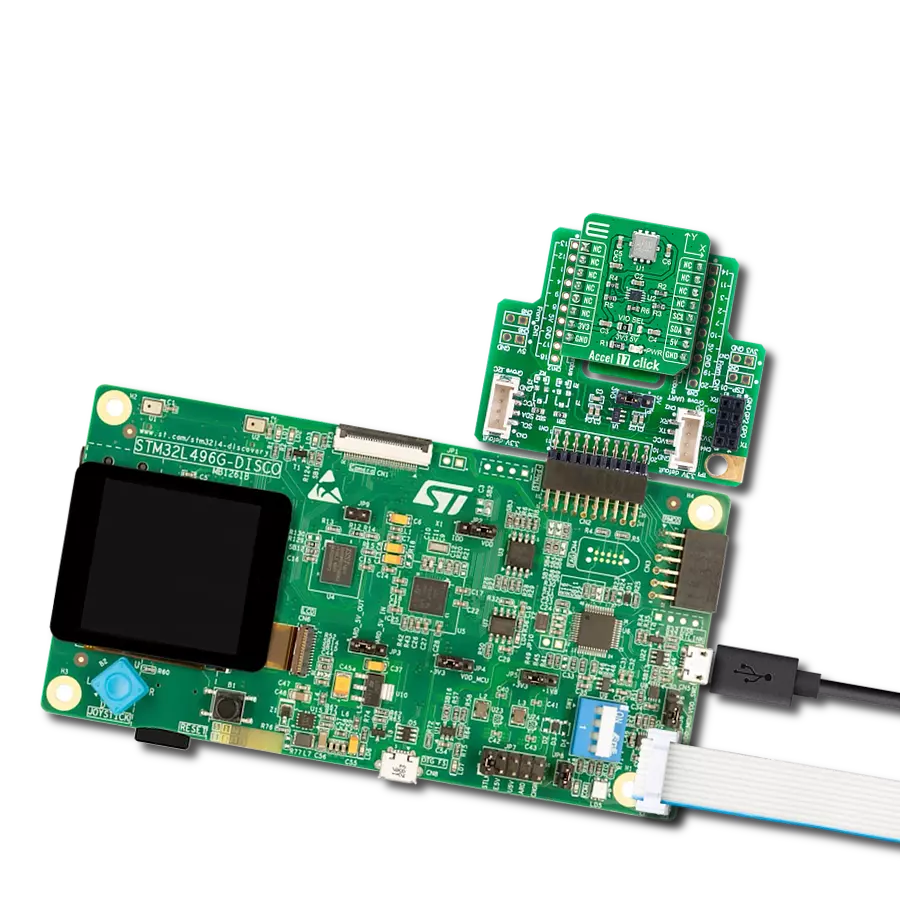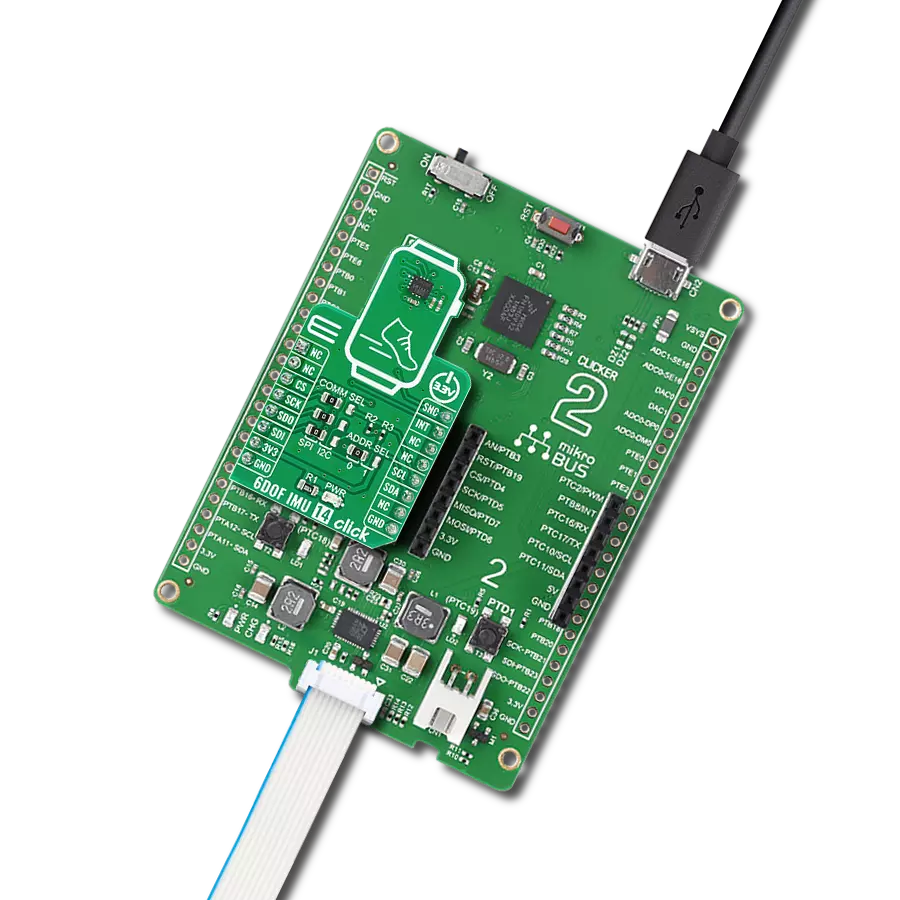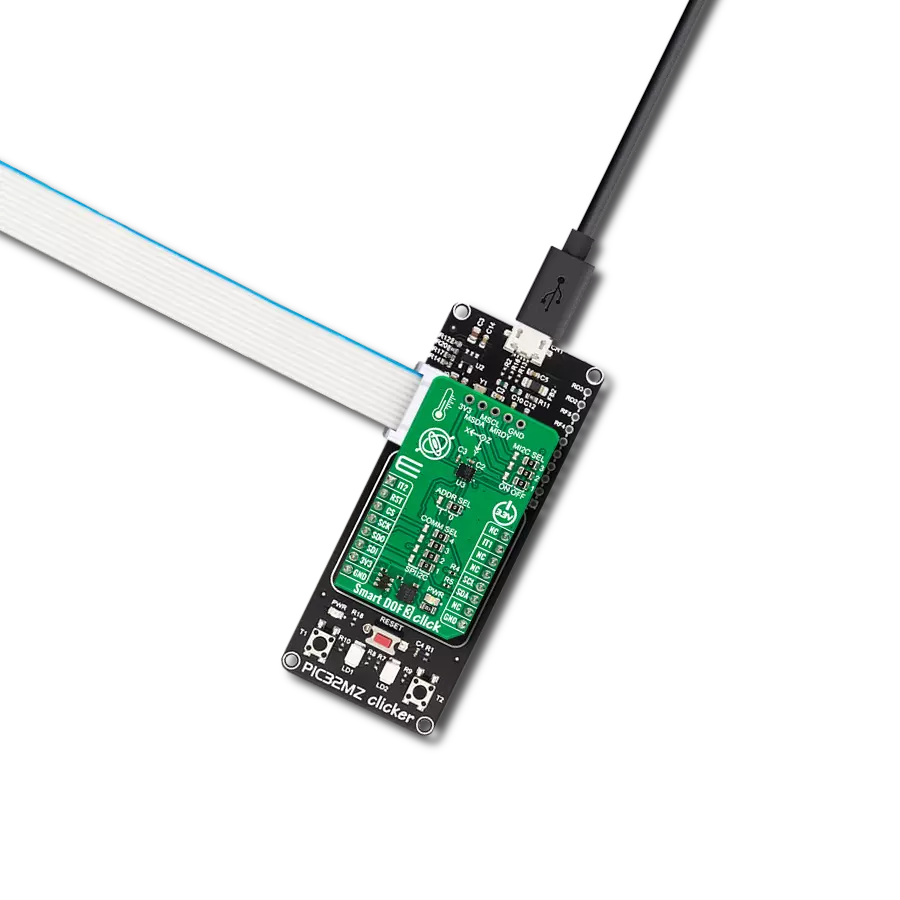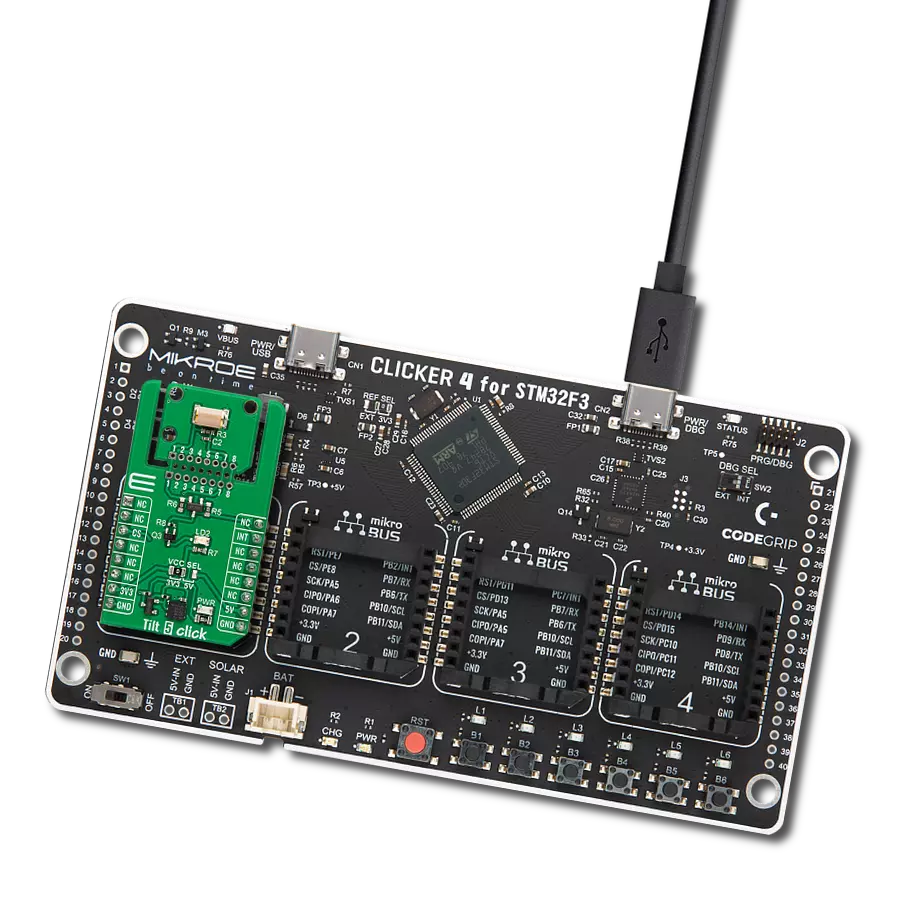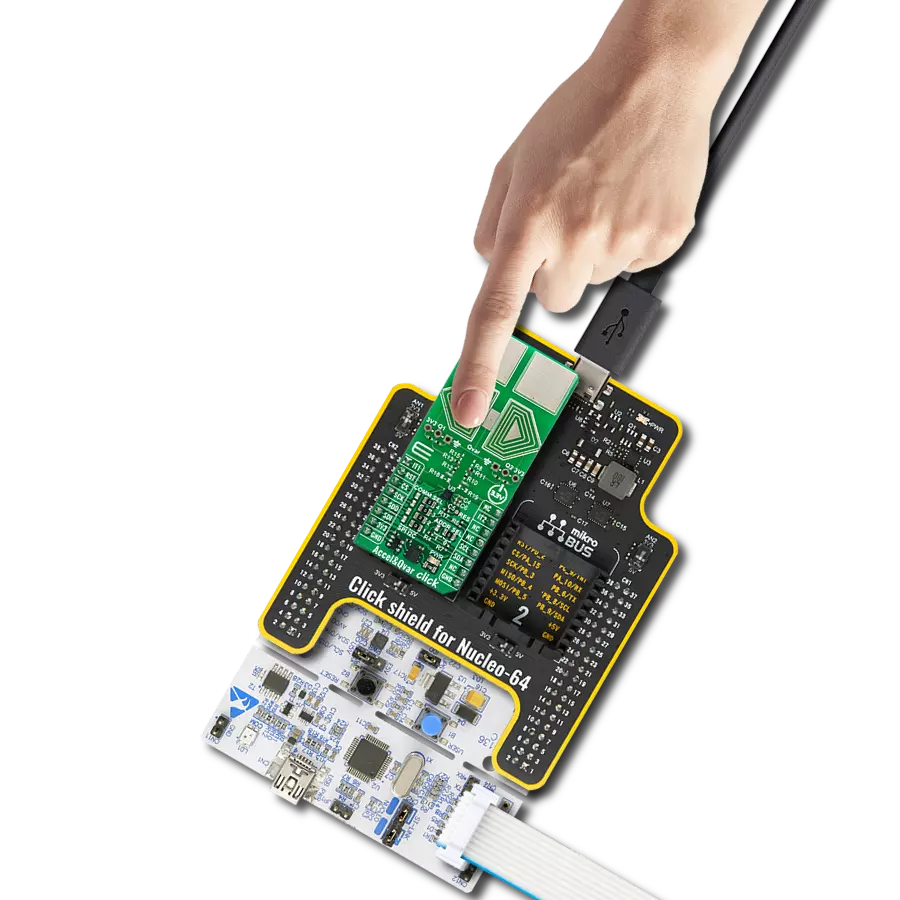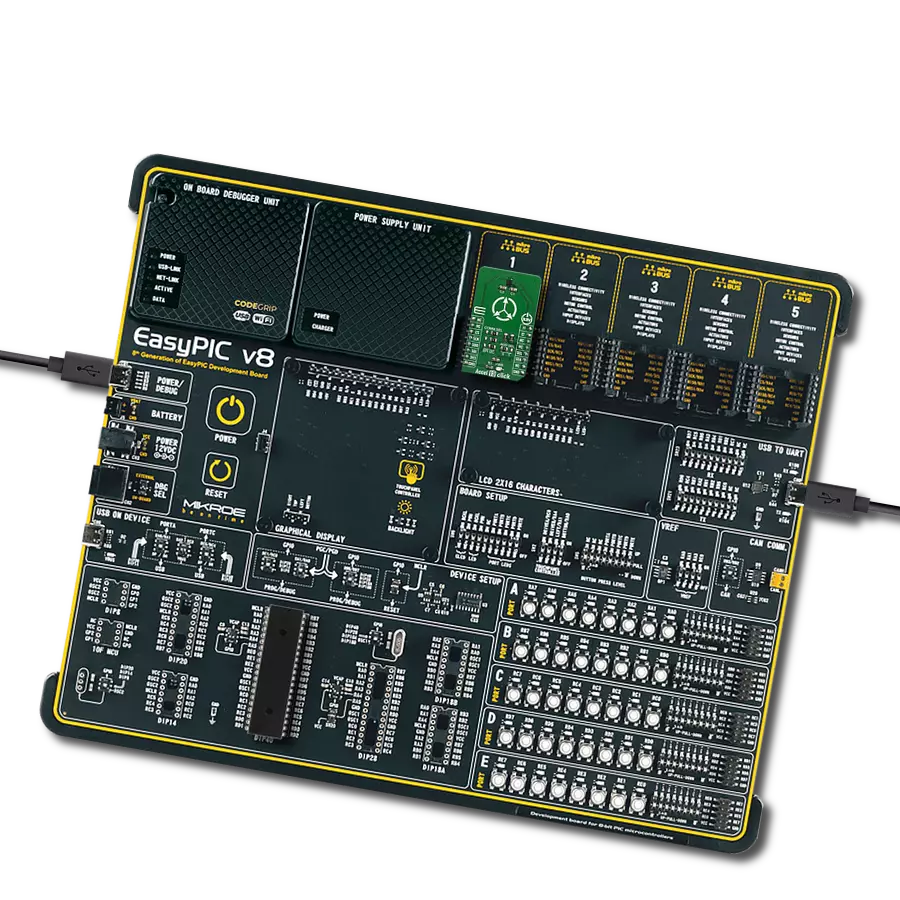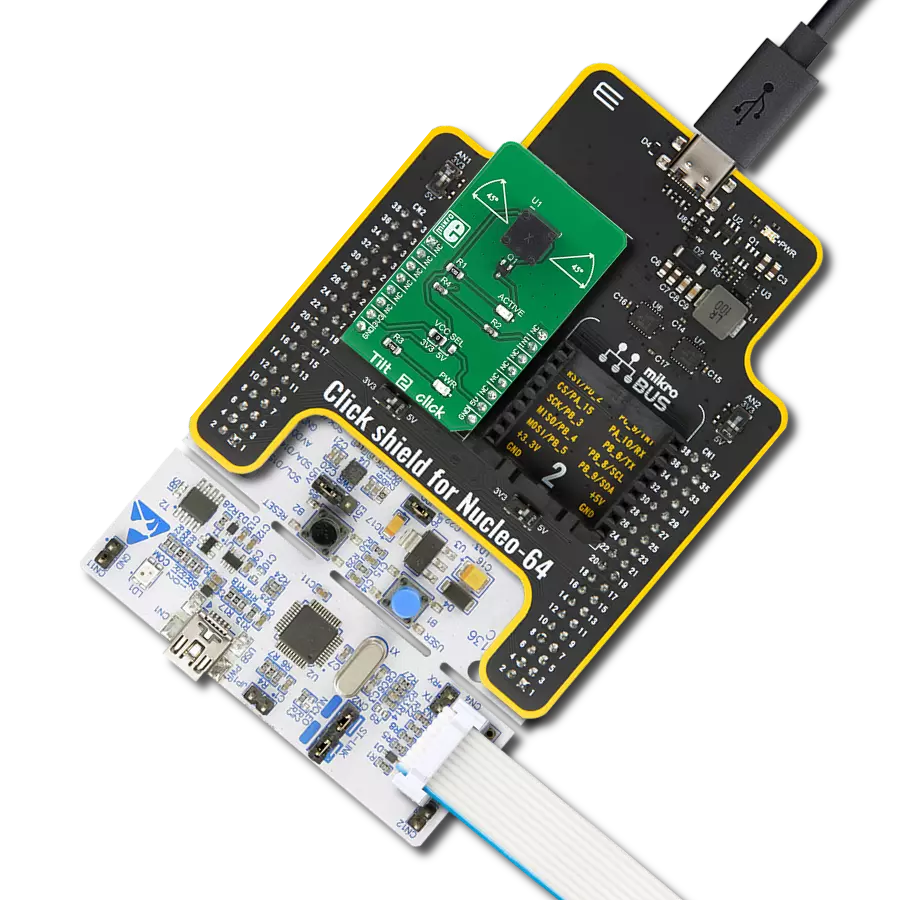Our 6DOF IMU solution empowers you to achieve precise motion and position tracking, opening doors to seamless navigation in various applications
A
A
Hardware Overview
How does it work?
6DOF IMU 3 Click is based on the FXOS8700CQ, a small, low-power, 3-axis, linear accelerometer and 3-axis magnetometer combined into a single package from NXP Semiconductor. The device features a selectable I2C or point-to-point SPI serial interface with a 14-bit accelerometer and 16-bit magnetometer ADC resolution and smart-embedded functions. The FXOS8700CQ has dynamically selectable acceleration full-scale ranges of ±2 g/±4 g/±8 g and a fixed magnetic measurement range of ±1200 μT. For each sensor, the user selects output data rates (ODR) from 1.563Hz to 800Hz. Interleaved magnetic and acceleration data is available at ODR rates up to 400Hz. The sensor's sensitivity is represented in mg/LSB for the accelerometer and μT/LSB for the magnetometer. The magnetometer sensitivity is
fixed at 0.1 μT/LSB. The accelerometer sensitivity changes with the full-scale range selected by the user. Accelerometer sensitivity is 0.244 mg/LSB in 2 g mode, 0.488 mg/LSB in 4 g mode, and 0.976 mg/LSB in 8 g mode, making it ideal for applications such as used for security, like motion detection, door opening, smart home applications, robotics and unmanned aerial vehicles (UAVs) with electronic compass (e-compass) function, in medical purposes, like patient monitoring, fall detection and more. 6DOF IMU 3 Click supports both SPI and I2C communication interfaces, allowing it to be used with various MCUs. The communication interface can be selected by moving SMD jumpers grouped under the COM SEL to an appropriate position (SPI or I2C). The slave I2C address can also be configured by an
SMD jumper when the Click board™ is operated in the I2C mode. An SMD jumper labeled ADDR SEL sets the least significant bit (LSB) of the I2C address. The I2C interface complies with fast mode (400 kHz) and normal mode (100 kHz) I2C standards, while the SPI interface is a classical Host/Peripheral serial port. The FXOS8700CQ is always considered as the peripheral and thus is never initiating the communication. This Click board™ can be operated only with a 3.3V logic voltage level. The board must perform appropriate logic voltage level conversion before using MCUs with different logic levels. Also, it comes equipped with a library containing functions and an example code that can be used as a reference for further development.
Features overview
Development board
PIC18F57Q43 Curiosity Nano evaluation kit is a cutting-edge hardware platform designed to evaluate microcontrollers within the PIC18-Q43 family. Central to its design is the inclusion of the powerful PIC18F57Q43 microcontroller (MCU), offering advanced functionalities and robust performance. Key features of this evaluation kit include a yellow user LED and a responsive
mechanical user switch, providing seamless interaction and testing. The provision for a 32.768kHz crystal footprint ensures precision timing capabilities. With an onboard debugger boasting a green power and status LED, programming and debugging become intuitive and efficient. Further enhancing its utility is the Virtual serial port (CDC) and a debug GPIO channel (DGI
GPIO), offering extensive connectivity options. Powered via USB, this kit boasts an adjustable target voltage feature facilitated by the MIC5353 LDO regulator, ensuring stable operation with an output voltage ranging from 1.8V to 5.1V, with a maximum output current of 500mA, subject to ambient temperature and voltage constraints.
Microcontroller Overview
MCU Card / MCU
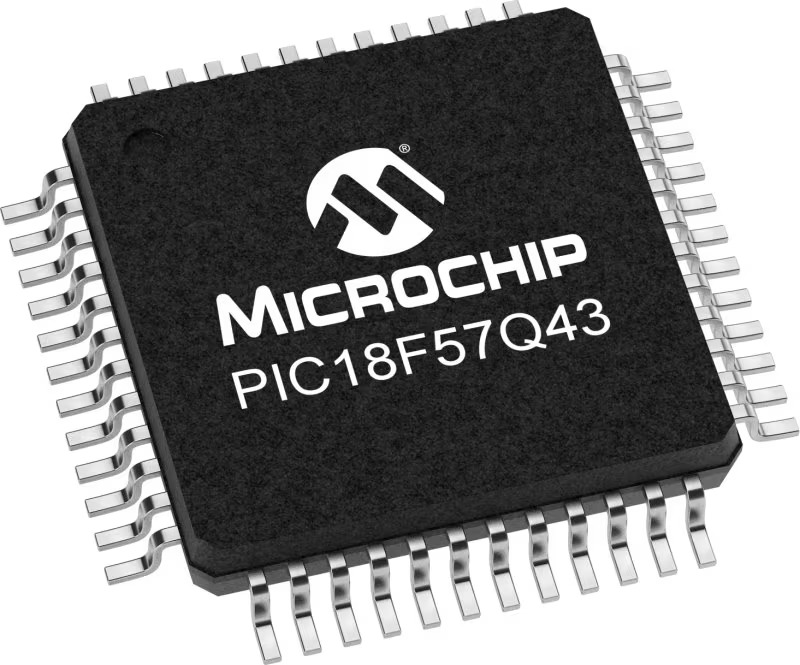
Architecture
PIC
MCU Memory (KB)
128
Silicon Vendor
Microchip
Pin count
48
RAM (Bytes)
8196
You complete me!
Accessories
Curiosity Nano Base for Click boards is a versatile hardware extension platform created to streamline the integration between Curiosity Nano kits and extension boards, tailored explicitly for the mikroBUS™-standardized Click boards and Xplained Pro extension boards. This innovative base board (shield) offers seamless connectivity and expansion possibilities, simplifying experimentation and development. Key features include USB power compatibility from the Curiosity Nano kit, alongside an alternative external power input option for enhanced flexibility. The onboard Li-Ion/LiPo charger and management circuit ensure smooth operation for battery-powered applications, simplifying usage and management. Moreover, the base incorporates a fixed 3.3V PSU dedicated to target and mikroBUS™ power rails, alongside a fixed 5.0V boost converter catering to 5V power rails of mikroBUS™ sockets, providing stable power delivery for various connected devices.
Used MCU Pins
mikroBUS™ mapper
Take a closer look
Click board™ Schematic

Step by step
Project assembly
Software Support
Library Description
This library contains API for 6DOF IMU 3 Click driver.
Key functions:
c6dofimu3_check_id- Function check device ID by read ID value from the sensor ID register address of FXOS8700CQ 6-axis sensor with integrated linear accelerometer and magnetometer on 6DOF IMU 3 Click board.c6dofimu3_read_mag_data- Function read 16-bit ( signed ) Magnetometer X-axis, Y-axis data and Z-axis data from the 6 targeted starts from C6DOFIMU3_M_OUT_X_MSB register address of FXOS8700CQ 6-axis sensor with integrated linear accelerometer and magnetometer on 6DOF IMU 3 Click board.c6dofimu3_read_accel_data- Function read 14-bit ( signed ) Accel X-axis, Y-axis data and Z-axis data from the 6 targeted starts from C6DOFIMU3_OUT_X_MSB register address of FXOS8700CQ 6-axis sensor with integrated linear accelerometer and magnetometer on 6DOF IMU 3 Click board.
Open Source
Code example
The complete application code and a ready-to-use project are available through the NECTO Studio Package Manager for direct installation in the NECTO Studio. The application code can also be found on the MIKROE GitHub account.
/*!
* \file
* \brief 6Dofimu3 Click example
*
* # Description
* This example demonstrates the use of 6DOF IMU 3 Click board.
*
* The demo application is composed of two sections :
*
* ## Application Init
* Initializes the driver and sets the device default configuration.
*
* ## Application Task
* Measures acceleration and magnetometer data and displays the results on USB UART each second.
*
* \author MikroE Team
*
*/
// ------------------------------------------------------------------- INCLUDES
#include "board.h"
#include "log.h"
#include "c6dofimu3.h"
// ------------------------------------------------------------------ VARIABLES
static c6dofimu3_t c6dofimu3;
static log_t logger;
c6dofimu3_accel_t accel_data;
c6dofimu3_mag_t mag_data;
// ------------------------------------------------------ APPLICATION FUNCTIONS
void application_init ( void )
{
log_cfg_t log_cfg;
c6dofimu3_cfg_t cfg;
/**
* Logger initialization.
* Default baud rate: 115200
* Default log level: LOG_LEVEL_DEBUG
* @note If USB_UART_RX and USB_UART_TX
* are defined as HAL_PIN_NC, you will
* need to define them manually for log to work.
* See @b LOG_MAP_USB_UART macro definition for detailed explanation.
*/
LOG_MAP_USB_UART( log_cfg );
log_init( &logger, &log_cfg );
log_info( &logger, "---- Application Init ----" );
// Click initialization.
c6dofimu3_cfg_setup( &cfg );
C6DOFIMU3_MAP_MIKROBUS( cfg, MIKROBUS_1 );
c6dofimu3_init( &c6dofimu3, &cfg );
c6dofimu3_default_cfg( &c6dofimu3 );
Delay_ms ( 100 );
}
void application_task ( void )
{
if ( c6dofimu3_check_data_ready( &c6dofimu3 ) )
{
c6dofimu3_get_data ( &c6dofimu3, &accel_data, &mag_data );
log_printf( &logger, " Accel X : %.2f mg \t Mag X : %.2f uT\r\n", accel_data.x, mag_data.x );
log_printf( &logger, " Accel Y : %.2f mg \t Mag Y : %.2f uT\r\n", accel_data.y, mag_data.y );
log_printf( &logger, " Accel Z : %.2f mg \t Mag Z : %.2f uT\r\n", accel_data.z, mag_data.z );
log_printf( &logger, "-------------------------------------\r\n" );
Delay_ms ( 800 );
}
}
int main ( void )
{
/* Do not remove this line or clock might not be set correctly. */
#ifdef PREINIT_SUPPORTED
preinit();
#endif
application_init( );
for ( ; ; )
{
application_task( );
}
return 0;
}
// ------------------------------------------------------------------------ END
Additional Support
Resources
Category:Motion




















